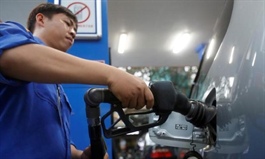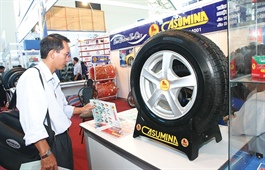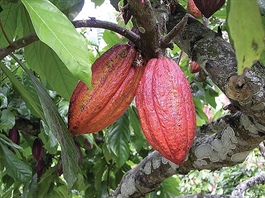Racing for rubber dominance
Racing for rubber dominance
When the US dollar recedes in the boom-and-bust cycle along with a global economic revival, the rubber market is slated to feel tight supply and increasing prices. Moreover, dealmaking activities in the landscape will be buoyant down the road due to the harsh competition between foreign and local players.

There is deep competition in rubber latex trading in Vietnam as national standards for such materials are still developing, photo Le Toan
|
The global rubber price is expected to see an upward trend in the second half of next year and may hit $2.45 per kilogramme as early as 2022. Particularly, as one of the most commonly traded commodities, rubber is envisaged to gradually gain, depending on actions taken by the next US administration in fighting economic slowdown next year.
Furthermore, a rebound from the Chinese manufacturing industry and a pick-up in automobile sales are also viewed as an impetus for the rubber sector.
Currently, Danang Rubber, Sao Vang Rubber, Southern Rubber Industry JSC (Casumina), and Inoue Rubber Vietnam are four major players in the local market, in all of which state-owned Vietnam National Chemical Group (Vinachem) has the ownership.
State-run Vietnam Rubber Group (VRG) has also made a big splash by announcing its efforts to strike up deals with Vinachem’s subsidiaries.
At a recent meeting with the Committee for Management of State Capital at Enterprises, VRG announced it is considering investment in tyre and tube production via mergers and acquisitions (M&A) with brands of Vinachem. The move will help VRC close the value chain of rubber products and will be the core for developing tyre and tube products in the future.
According to Vinachem’s restructuring plan for the 2017-2020 period, the group was to divest three tyre companies to below 51 per cent. Vinachem organised an auction of 17.2 million Danang Rubber shares with a starting price of VND25,170 ($1.09) apiece in May 2019 – however, the auction failed to attract investors as anticipated. Vinachem remains the parent company holding nearly 60 million shares of Danang Rubber, equivalent to 50.51 per cent of charter capital.
In contrast, the group did successfully sell 4.2 million shares of Sao Vang Rubber with the initial price of VND46,452 ($2.01) apiece. After divestment, Vinachem holds 36 per cent of charter capital.
Similarly, Casumina has been stepping up its divestment plan to move from 51 to 36 per cent. Saigon VRG Investment, a subsidiary of VRG, purchased more Casumina shares in July last year in order to raise its ownership to over 8 per cent of charter capital.
Meanwhile, Inoue Rubber Vietnam is a joint venture between Vinachem, Japan Inoue Rubber, and Bridgestone Corporation. The company specialises in manufacturing tyres in the northern province of Vinh Phuc for world-famous automobile companies such as Honda and Yamaha.
As of present, VRG has yet to finalise its M&A plan. However, if these deals are successful, it would likely breathe new life into the whole industry, helping local players to consolidate their presence in order to compete with foreign counterparts.
Harsh competition
Experts at Vietcombank Securities Company (VCBS) told VIR that a weaker US dollar tends to boost all dollar-denominated commodities, so the rubber price will recover or even reach a new high.
Meanwhile, R.B. Premadasa, general secretary of the Association of Natural Rubber Producing Countries, said rubber production across the globe was expected to witness further capacity addition until around 2023, and then stagnate thereafter.
“If prices become attractive coinciding with the stagnation of mature areas between 2023 and 2024, farmers are expected to adopt short-term measures to maximise the yield from existing trees. In that case, average yield from existing mature trees can improve in the next year,” Premadasa said in a recent announcement.
VCBS states that risks for rubber firms in Vietnam are still lingering. In the case of Casumina, the company has paid a large amount of money to deal with waste problems to protect the environment and pressure relocation of the company’s plants out of Ho Chi Minh City.
“Meanwhile, there are many foreign players entering into domestic market, approaching many market segments including current and potential segments of the company. The material rubber price is on an upward trend so it will affect to the final product price of the business,” VCBS highlighted.
Casumina’s pre-tax profit reached nearly VND40 billion ($1.72 million) in the first half of 2020, while that of Danang Rubber reached VND107 billion ($4.64 million).
Casumina said that its profit was considerably affected by the high interest expense, as well as the all-steel radial tyre segment that has not yet reached break-even point.
At present, there are almost 250 private enterprises and establishments engaged in rubber processing, with a capacity of over 1.24 billion tonnes per year. The total capacity of the current processing facilities exceeds the rubber output by 15-20 per cent.
There are still some limitations, as no national standards for rubber materials have yet been developed – as a result price regulations have not been achieved, instead depending on the world market. Moreover, there is no national rubber-processing facility planning, thus many private construction facilities are spontaneous and results in competition in rubber latex trading.
Looking on the bright side, Casumina believes that implmented free trade agreements such as the EU-Vietnam Free Trade Agreement, the Comprehensive and Progressive Agreement for Trans-Pacific Partnership, and the newly-ratified Regional Comprehensive Economic Partnership will further strengthen the company’s footprint in other countries. These deals are envisaged to boost regional and global supply chains as well as exports, including rubber products.
In addition, the Vietnamese strategy of infrastructure development together with the evolution of the domestic automobile manufacturing and assembling industry is paving the way for tyre manufacturers to grow.
Impressive profits
In 2019, Vietnam’s passenger car tyre exports to the US rose by 14 per cent to $469.6 million, from $411.43 million in 2018, cited from data compiled by the US Census Bureau.
Specifically, foreign-invested enterprises (FIEs) are outweighing local ones in terms of production scale and quality, while the price of automobile tyres and tubes originating from China is lower (around 10-15 per cent) compared to domestic products of the same category.
Sailun Vietnam, a subsidiary of Chinese tyre giant Sailun, recorded that its profit tripled from VND1.15 trillion ($49.79 million) in 2017 to VND3.14 trillion ($135.96 million) last year. Elsewhere, Cheng Shin Rubber Vietnam, a local franchise of Taiwan’s Maxxis Group, recorded 2019 profit of VND587 billion ($25.42 million).
Some other FIEs such as Kumho Tire Vietnam and Kenda Rubber Vietnam also achieved impressive after-tax profits last year, at VND200 billion ($8.66 million) and VND248 billion ($10.7 million) respectively.
In terms of production scale, such FIEs are larger compared to domestic equivalents. Specifically, the annual radial tyre capacity of Sailun Vietnam reached 12 million tyres, Kumho Tire Vietnam churned out 6.3 million tyres, and Bridgestone Vietnam manufactured 17 million products, while the largest domestic companies also only achieved about one million tyres per year.























